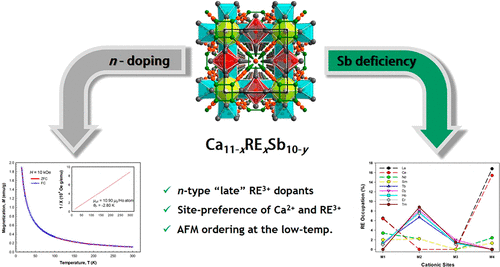当前位置:
X-MOL 学术
›
Cryst. Growth Des.
›
论文详情
Our official English website, www.x-mol.net, welcomes your
feedback! (Note: you will need to create a separate account there.)
Site-Selective n-Type “Heavy” Rare-Earth-Metal Doping in the Complex Zintl Phase Ca11–xRExSb10–y (RE = Tb, Dy, Ho, Er, Tm)
Crystal Growth & Design ( IF 3.2 ) Pub Date : 2020-04-29 , DOI: 10.1021/acs.cgd.0c00311 Junsu Lee 1 , Hayeon Sa 1 , Hongil Jo 2 , Dohyun Moon 3 , Kang Min Ok 2 , Tae-Soo You 1
Crystal Growth & Design ( IF 3.2 ) Pub Date : 2020-04-29 , DOI: 10.1021/acs.cgd.0c00311 Junsu Lee 1 , Hayeon Sa 1 , Hongil Jo 2 , Dohyun Moon 3 , Kang Min Ok 2 , Tae-Soo You 1
Affiliation

|
Five novel Zintl phases belonging to the ternary Ca11–xRExSb10–y (RE = Tb, Dy, Ho, Er, Tm; 0.35(6) ≤ x ≤ 0.41(4), 0.27(1) ≤ y ≤ 0.51(2)) system were successfully synthesized by the arc-melting method, and their crystal structures were carefully determined by using powder and single-crystal X-ray diffraction (PXRD and SXRD) analyses. Large amounts of nicely grown plate-shaped single crystals were easily obtained using this relatively facile synthetic method, and all title compounds adopted the tetragonal I4/mmm space group with Z = 4 and a Pearson code of tI84. This isotypic Ho11Ge10-type structure of the title compounds can be illustrated as a combination of (1) three different types of cationic coordination polyhedra centered by three isolated Sb atoms and (2) three-dimensional (3D) anionic frameworks formed by two different types of Sb atoms. These ternary compounds successfully accommodated the n-type RE3+ dopants at the Ca2 (Wyckoff 16n) site of the parental binary Ca11Sb10, and this particular site preference can be elucidated by the substituting cationic size and the volume of the provided cationic site. A series of theoretical calculations were also performed using the hypothetical model Ca10.5Ho0.5Sb10 by the tight-binding linear muffin-tin orbital (TB-LMTO) method. Thorough analyses of crystal orbital Hamilton population (COHP) curves proved that the antibonding character of the Sb3–Sb3 bond induced the observed deficiencies of the square Sb4 sites. Magnetic property measurements performed for three title compounds, Ca10.59(4)Dy0.41Sb9.71(1), Ca10.61(3)Ho0.39Sb9.69(1), and Ca10.64(3)Er0.36Sb9.73(1), indicated the antiferromagnetic (AFM) interactions of RE elements at relatively low temperatures with paramagnetic Curie temperatures of −2.24, −2.80, and −2.98 K, respectively.
中文翻译:

复杂Zintl相中的位点选择性n型“重”稀土金属掺杂Ca 11– x RE x Sb 10– y(RE = Tb,Dy,Ho,Er,Tm)
五个新颖津特耳相属于三元钙11- X RE X Sb的10- Ŷ(RE = Tb时,镝,钬,铒,铥; 0.35(6)≤ X ≤0.41(4),0.27(1)≤ ÿ ≤通过电弧熔化法成功合成了0.51(2))系统,并通过粉末和单晶X射线衍射(PXRD和SXRD)分析仔细确定了它们的晶体结构。使用这种相对简便的合成方法,很容易获得大量生长良好的板状单晶,并且所有标题化合物均采用Z = 4且Pearson码为tI 84的四方I 4 / mmm空间基团。标题化合物的11 Ge 10型结构可以说明为(1)以三个孤立的Sb原子为中心的三种不同类型的阳离子配位多面体和(2)由两种不同类型形成的三维(3D)阴离子骨架的组合锑原子。这些三元化合物成功地在亲代二元Ca 11 Sb 10的Ca2(Wyckoff 16n)位点处容纳了n型RE 3+掺杂剂,可以通过用阳离子大小和所提供阳离子的体积来说明这一特定的位点偏好。现场。还使用假设模型Ca 10.5 Ho 0.5 Sb进行了一系列理论计算10由紧密结合的线性松饼锡轨道(TB-LMTO)方法。对晶体轨道汉密尔顿人口(COHP)曲线的透彻分析表明,Sb3–Sb3键的反键特征引起了方形Sb 4位点的缺陷。对三种标题化合物Ca 10.59(4) Dy 0.41 Sb 9.71(1),Ca 10.61(3) Ho 0.39 Sb 9.69(1)和Ca 10.64(3) Er 0.36 Sb 9.73(1)进行磁性能测量,表明稀土元素在相对低温下的顺磁性居里温度分别为-2.24,-2.80和-2.98 K的反铁磁(AFM)相互作用。
更新日期:2020-07-01
中文翻译:

复杂Zintl相中的位点选择性n型“重”稀土金属掺杂Ca 11– x RE x Sb 10– y(RE = Tb,Dy,Ho,Er,Tm)
五个新颖津特耳相属于三元钙11- X RE X Sb的10- Ŷ(RE = Tb时,镝,钬,铒,铥; 0.35(6)≤ X ≤0.41(4),0.27(1)≤ ÿ ≤通过电弧熔化法成功合成了0.51(2))系统,并通过粉末和单晶X射线衍射(PXRD和SXRD)分析仔细确定了它们的晶体结构。使用这种相对简便的合成方法,很容易获得大量生长良好的板状单晶,并且所有标题化合物均采用Z = 4且Pearson码为tI 84的四方I 4 / mmm空间基团。标题化合物的11 Ge 10型结构可以说明为(1)以三个孤立的Sb原子为中心的三种不同类型的阳离子配位多面体和(2)由两种不同类型形成的三维(3D)阴离子骨架的组合锑原子。这些三元化合物成功地在亲代二元Ca 11 Sb 10的Ca2(Wyckoff 16n)位点处容纳了n型RE 3+掺杂剂,可以通过用阳离子大小和所提供阳离子的体积来说明这一特定的位点偏好。现场。还使用假设模型Ca 10.5 Ho 0.5 Sb进行了一系列理论计算10由紧密结合的线性松饼锡轨道(TB-LMTO)方法。对晶体轨道汉密尔顿人口(COHP)曲线的透彻分析表明,Sb3–Sb3键的反键特征引起了方形Sb 4位点的缺陷。对三种标题化合物Ca 10.59(4) Dy 0.41 Sb 9.71(1),Ca 10.61(3) Ho 0.39 Sb 9.69(1)和Ca 10.64(3) Er 0.36 Sb 9.73(1)进行磁性能测量,表明稀土元素在相对低温下的顺磁性居里温度分别为-2.24,-2.80和-2.98 K的反铁磁(AFM)相互作用。











































 京公网安备 11010802027423号
京公网安备 11010802027423号